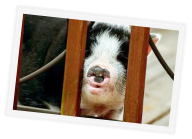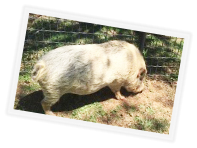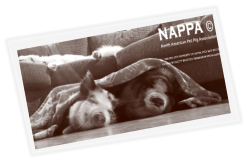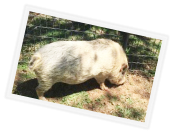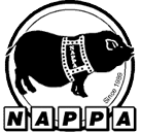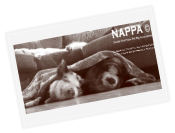BACK TO TOP
FOR MORE INFORMATION, E-MAIL: nappapignews@yahoo.com
2022-2025 Designed by: WimberlysWebWorks.com

Potbellied Pigs share many of the same advantages as our cats and dogs. They are intelligent
creatures and, in the right environment, make loving and devoted companion animals. To
their disadvantage, they are a newer and less traditional type of pet, and municipalities have
been slow to recognize Potbellies as companion animals. Branded as livestock in most places, many pigs
have been forced to leave their loving families. The lucky ones get relocated, either to homes with pig-
friendly zoning or to one of the many Potbellied Pigs sanctuaries around the US and Canada. The unlucky
ones can suffer a fate of Craigslist, neglect or even slaughter. And while many cats and dogs suffer a
similar fate, in places where potbellies are designated as livestock, slaughter is not illegal.
Here is some background and information about Potbellied Pigs
In 1985, Keith Connell, a Canadian zoo director, imported 16 black potbellies into Canada as breeding stock for zoological gardens. In 1989 a second line of Potbellies (predominantly white) arrived in Texas. Most Potbellied Pigs in the USA can be traced back to these two lines. Others took notice of these unique animals and interest in their small size, gentle disposition, immense affection and keen intelligence grew. Before long they had spilled into the pet market. NAPPA, (North American Pet Pig Association) the oldest Potbellied Pigs association in United States has issued a Potbellied Pig Breed Standard. The only correct and complete name for this pig is Vietnamese Miniature Potbellied Pig. Miniature, in this case, is used to distinguish from commercial hogs. Vietnamese Potbellied Pigs are composed of various Southeast Asia breeds of pigs and have evolved over millions of years. Potbellied Pigs have certain characteristics that separate them from other breeds of pigs. A Potbellied Pigs continues to grow for at least three to four years. The following guidelines pertain to purebred (not cross-bred) healthy Potbellied Pigs: • Birth to one year: average weight gain is one pound per week with acceptance range between forty to eighty pounds at one year. Measurements range from fourteen to twenty six inches in height, with the length being proportioned to the height. Certainly there are some Potbellied Pigs who are smaller or larger than this range. Pigs of this age are very active and playful. • One year to five years: The pig’s growth will stop around 4 years of age, typically reaching the 100 to 150 pound mark, some closer to 200. An average pig might be 120 pounds, 20 inches high and 36” in length. During this time the Potbellied Pig will move from a teenager to an adult. Many guardians say that somewhere between one and two years their pig “gets the hang of what is expected”. The need for continuous monitoring and training, which has been required for the younger pig, is greatly reduced. The older pigs seem to more clearly understand the expectations of their guardian. As for living accommodations, Potbellied Pigs require access both to the indoors and outdoors. They are easily trained to either use a litterbox or to potty outdoors. A pig will choose one part of the yard to poop and stick to this. Pigs love to graze and root, so having a few holes in your grass will be normal. A pig will need a sleeping area free from drafts and will need blankets in which to snuggle – they have a sparse coat and love to be cozy. Outdoors, a fenced yard is a must. Dog attacks are a real danger and pigs have no defense against this. Pigs, like people, are social creatures, in nature always living in a family unit. Even with a loving human, a single pig can be prone to boredom and even depression. If a second pig is not an option, a cat can be a welcome friend. The dog and pig combination is not recommended. Even when a dog and pig appear to get along, they should never be left alone without supervision. Pet pigs must have a suitable veterinarian, along with transportation for visits and emergencies. They need vaccinations and regular hoof and tusk trims. Some plants are poisonous to them, and because they are prey animals, must be kept safe from all predators such as dogs, owls, coyotes, snakes, foxes and wolves. They must be fed a proper and controlled diet. Left to their own devices, a pig WILL overeat, and that’s when a lot of problems begin. A pig can be a little round, but obesity brings on much misery, such as lameness, blindness, deafness and early death. Advantages: • Long life span (12-20 years) • Clean and odor free • Non-allergenic in most cases • No fleas • Very little shedding • Quickly trained: litterbox, tricks, harnesses, etc… • They are not “chewers” • Quiet when outdoors • Low maintenance: annual vet visit, low food consumption • Communicative, affectionate, intelligent NAPPA promotes education to the general public, and supplies support and information to owners of potbellied pigs. We are working to change the potbellied pig’s designation from livestock to companion animals so that municipalities will allow these loving and intelligent creatures to live out the lives they deserve.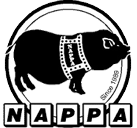


Mini Pigs as Companion Pets
BACK TO TOP
FOR MORE INFORMATION,
E-MAIL: nappapignews@yahoo.com
2022-2025 Designed by: WimberlysWebWorks.com
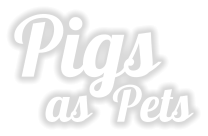
Potbellied Pigs share many of the same advantages as
our cats and dogs. They are intelligent creatures and,
in the right environment, make loving and devoted
companion animals. To their disadvantage, they are a
newer and less traditional type of pet, and
municipalities have been slow to recognize Potbellies
as companion animals. Branded as livestock in most
places, many pigs have been forced to leave their
loving families. The lucky ones get relocated, either to
homes with pig-friendly zoning or to one of the many
Potbellied Pigs sanctuaries around the US and
Canada. The unlucky ones can suffer a fate of
Craigslist, neglect or even slaughter. And while many
cats and dogs suffer a similar fate, in places where
potbellies are designated as livestock, slaughter is not
illegal.
Here is some background and information
about Potbellied Pigs
In 1985, Keith Connell, a Canadian zoo director, imported 16 black potbellies into Canada as breeding stock for zoological gardens. In 1989 a second line of Potbellies (predominantly white) arrived in Texas. Most Potbellied Pigs in the USA can be traced back to these two lines. Others took notice of these unique animals and interest in their small size, gentle disposition, immense affection and keen intelligence grew. Before long they had spilled into the pet market. NAPPA, (North American Pet Pig Association) the oldest Potbellied Pigs association in United States has issued a Potbellied Pig Breed Standard. The only correct and complete name for this pig is Vietnamese Miniature Potbellied Pig. Miniature, in this case, is used to distinguish from commercial hogs. Vietnamese Potbellied Pigs are composed of various Southeast Asia breeds of pigs and have evolved over millions of years. Potbellied Pigs have certain characteristics that separate them from other breeds of pigs. A Potbellied Pigs continues to grow for at least three to four years. The following guidelines pertain to purebred (not cross-bred) healthy Potbellied Pigs: • Birth to one year: average weight gain is one pound per week with acceptance range between forty to eighty pounds at one year. Measurements range from fourteen to twenty six inches in height, with the length being proportioned to the height. Certainly there are some Potbellied Pigs who are smaller or larger than this range. Pigs of this age are very active and playful. • One year to five years: The pig’s growth will stop around 4 years of age, typically reaching the 100 to 150 pound mark, some closer to 200. An average pig might be 120 pounds, 20 inches high and 36” in length. During this time the Potbellied Pig will move from a teenager to an adult. Many guardians say that somewhere between one and two years their pig “gets the hang of what is expected”. The need for continuous monitoring and training, which has been required for the younger pig, is greatly reduced. The older pigs seem to more clearly understand the expectations of their guardian. As for living accommodations, Potbellied Pigs require access both to the indoors and outdoors. They are easily trained to either use a litterbox or to potty outdoors. A pig will choose one part of the yard to poop and stick to this. Pigs love to graze and root, so having a few holes in your grass will be normal. A pig will need a sleeping area free from drafts and will need blankets in which to snuggle – they have a sparse coat and love to be cozy. Outdoors, a fenced yard is a must. Dog attacks are a real danger and pigs have no defense against this. Pigs, like people, are social creatures, in nature always living in a family unit. Even with a loving human, a single pig can be prone to boredom and even depression. If a second pig is not an option, a cat can be a welcome friend. The dog and pig combination is not recommended. Even when a dog and pig appear to get along, they should never be left alone without supervision. Pet pigs must have a suitable veterinarian, along with transportation for visits and emergencies. They need vaccinations and regular hoof and tusk trims. Some plants are poisonous to them, and because they are prey animals, must be kept safe from all predators such as dogs, owls, coyotes, snakes, foxes and wolves. They must be fed a proper and controlled diet. Left to their own devices, a pig WILL overeat, and that’s when a lot of problems begin. A pig can be a little round, but obesity brings on much misery, such as lameness, blindness, deafness and early death. Advantages: • Long life span (12-20 years) • Clean and odor free • Non-allergenic in most cases • No fleas • Very little shedding • Quickly trained: litterbox, tricks, harnesses, etc… • They are not “chewers” • Quiet when outdoors • Low maintenance: annual vet visit, low food consumption • Communicative, affectionate, intelligent NAPPA promotes education to the general public, and supplies support and information to owners of potbellied pigs. We are working to change the potbellied pig’s designation from livestock to companion animals so that municipalities will allow these loving and intelligent creatures to live out the lives they deserve.











